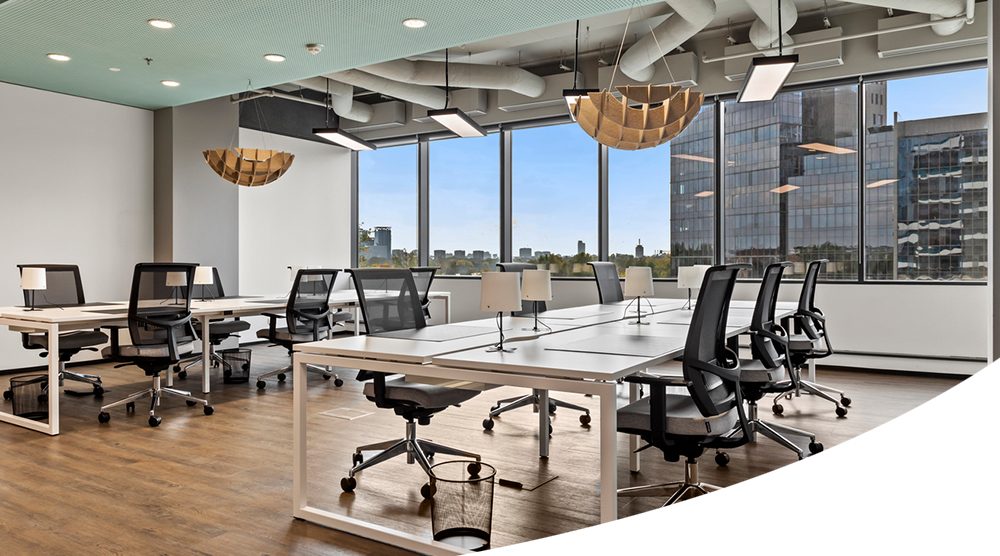Sensory Wellness: A Multi-Sensory Approach to Office Design
Multisensory office design focuses on optimizing various sensory elements – sight, sound, touch, smell, and taste – to enhance employee well-being and work efficiency. This approach creates a balanced, healthy, and stimulating environment by carefully selecting materials, colors, and textures, as well as controlling acoustics and lighting. Research shows that providing a sensory wellness within a workplace can lead to increased productivity, reduced anxiety and stress, while supporting creativity and innovative thinking.
Sight: Lighting and visual aesthetics
Sight: Lighting and visual aesthetics
In designing an inspiring workplace, sight is fundamental. Therefore, focusing on the office’s visual aesthetics like color schemes and lighting is highly recommended.
Thoughtful color selection can evoke various emotions and drive specific behaviors among employees. Here are a few examples:
- Vibrant, bold colors may enhance focus and accuracy
- Calming hues like blue and green inspire and relax
- Neutral tones such as grays and whites, often perceived as sterile, should be used carefully
Lighting plays a critical role too. As further explained in this study, cooler light, such as natural sunlight, is found to make workers more productive. Sunlight exposure is particularly beneficial for office workers, decreasing depression and improving mood, energy, alertness, and productivity.
Sound: Acoustic comfort
Sound: Acoustic comfort
Another important factor during work is sound. In achieving comfort, addressing noise pollution is key. Soundproofing techniques, such as acoustic panels and sound-absorbing materials, play a vital role in minimizing disruptive noise in the office.
On the other hand, natural sounds or white noise can significantly enhance the work environment. These sounds mask distracting noises and create a soothing background, aiding concentration and reducing stress.
Touch: Ergonomics and textures
Touch: Ergonomics and textures
In terms of touch, textures and surfaces should be considered. Furniture, particularly seating, plays a key role. Striking the right balance between hard and soft seating is essential for both functionality and comfort. Varied textures not only enhance physical comfort and reduce stress but also add a homely feel to the workspace.
However, tactile elements aren’t the only consideration. Thermal comfort is equally important in sensory wellness. A study from Cornell University focused on the impact of temperature on office work performance. The results showed that performance increases with temperatures up to 21-22°C and decreases with temperatures above 23-24°C. The highest productivity was observed at around 22°C. Maintaining a suitable office temperature boosts employees’ willingness to work and enhances overall productivity, whereas extreme temperatures (too cold or too hot) can lead to discomfort and frustration.
Smell: Scents in the workplace
Smell: Scents in the workplace
For different office areas, specific scents are recommended: citrus boosts energy and concentration in workspaces, lavender in break rooms aids relaxation, and peppermint in meeting areas enhances alertness and memory. Thoughtfully chosen fragrances can create a positive and productive environment, enhancing both well-being and performance in the workplace.
Taste: Food and drinks
Taste: Food and drinks
Offering nutritious snacks and beverages boosts employees’ mood and supports focus and productivity. A well-equipped kitchen or breakout area with coffee and tea facilities encourage staff to pause for meals and conversations. This not only nurtures a sense of belonging but also supports their health and work efficiency. Encouraging these breaks allows employees to refresh and connect, contributing positively to the organization’s culture.
Why care about sensory wellness in the office?
Why care about sensory wellness in the office?
When employees find their work environment comfortable, health-promoting, and engaging, they feel more secure and motivated to come to the office. This approach leads to healthier staff who typically experience reduced stress levels, lower absenteeism due to sickness, and improved overall physical and mental well-being.
Interested in how to create the ideal work environment to boost productivity and employee morale? Learn more about the psychology of common areas in an office space.

Do not hesitate to contact us
Get in touch, if you have any question


